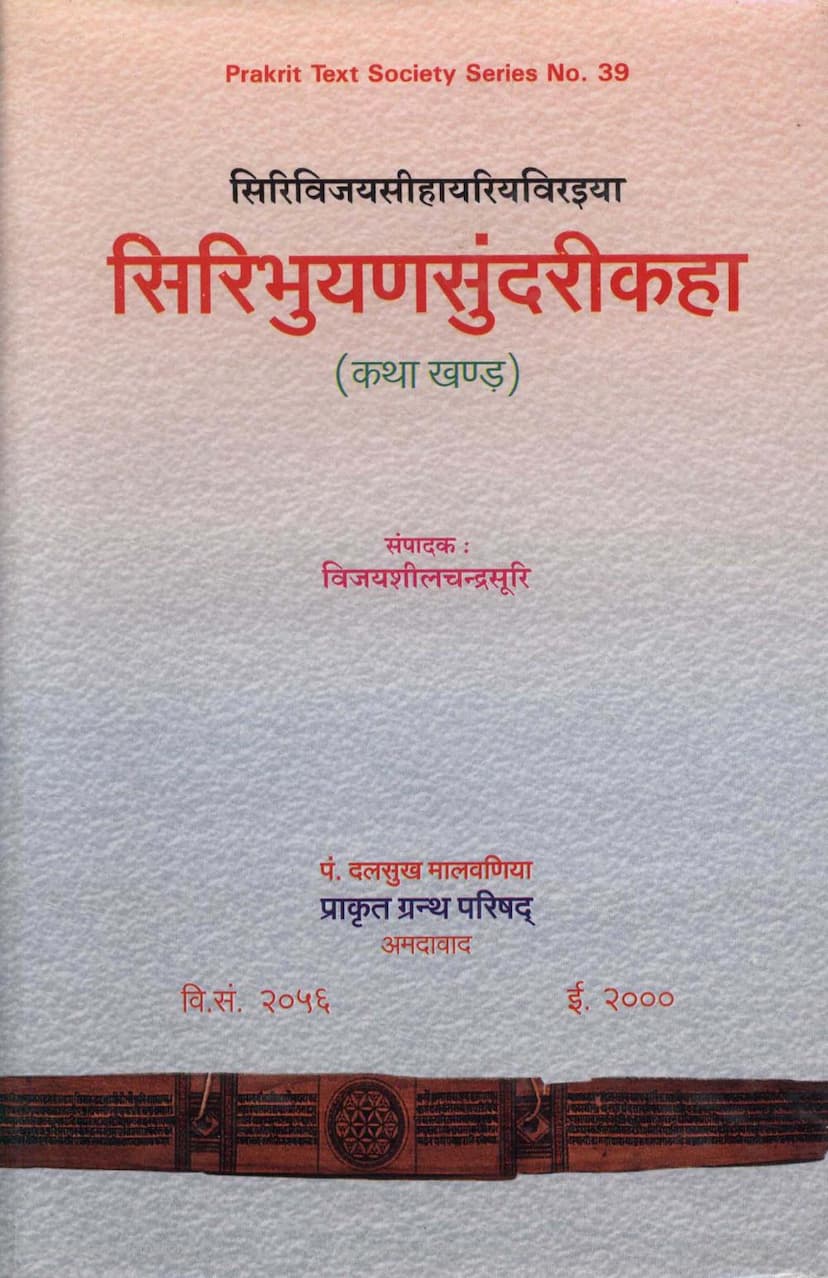Siribhuyansundarikaha
Added to library: September 2, 2025

Summary
The provided text is the Gujarati translation of the Jain text Siribhuyansundarikaha. Here's a comprehensive summary in English:
Book Title: Siribhuyansundarikaha (Bhuvana Sundari Katha) Author(s): Sinhsuri (Vijayasimhasuri), Shilchandrasuri (Vijayshilchandrasuri - editor) Publisher: Prakrit Text Society Ahmedabad Series: Prakrit Text Society Series No. 39 Year of Publication: 2000 AD (2056 VS)
General Overview:
Siribhuyansundarikaha is a voluminous narrative work in Prakrit, attributed to Acharya Vijayasimhasuri, who is believed to have lived in the 10th century AD. The text was meticulously edited and published by Acharya Vijayshilchandrasuri based on two manuscripts. The work is a story that delves into the lives, actions, and spiritual journeys of its characters, likely within the framework of Jain philosophy and ethics, as is typical of Jain narrative literature.
Key Information and Content Highlights from the Provided Pages:
- Author and Editor: The text is authored by Vijayasimhasuri and edited by Vijayshilchandrasuri. The publisher is the Pandit Dalsukh Malvania Prakrit Granth Parishad, Ahmedabad. The work is dedicated to Acharya Shri Vijaykastursurishwarji on his birth centenary.
- Dating: While the exact year of composition is not specified in the text, scholars, based on the Brihattíppanika, suggest it might be 975 VS. However, Dr. Madhusudan Dhanki suggests it could be 975 of the Shaka era (1053 AD), as the author mentions the poet Dhanpal (Gatha 11), whose era is considered to be the 10th-11th century AD. This dating makes the chronology consistent.
- Location of Composition: The Prashasti (epigraphical preface) indicates that the work was composed in Someshwar Nagar (Prabhas Patan).
- Scope and Content: The narrative is extensive, with approximately 8944 verses in the main story, excluding the Prashasti. The editor notes that the heroine, Bhuvana Sundari, and her story do not appear to have mentions in earlier Jain literature, a departure from the Jain tradition of adhering to scriptural authority or precursor accounts. The author himself seems to anticipate potential criticism for creating a narrative without prior scriptural backing, as indicated by the inclusion of certain gathas (verses 27-29) that discuss the nature and purpose of recounting the lives of past individuals.
- Influence: The Bhuvanasundari Katha is noted to have served as the basis for Acharya Jayatilaksurishvarji's Sanskrit work, Harivikramcharitra. Although Vijayasimhasuri's work is not directly cited, the thematic progression of Harivikramcharitra suggests it is a concise Sanskrit adaptation of the Prakrit narrative.
- Manuscript Basis: The primary manuscript for this edition is a palm-leaf manuscript from the Shri Shantinath Jain Jñānbhandar in Khambhat, possibly dating back to the 12th century AD (Muní Puṇyavijay suggests the early 13th century). A paper manuscript from the Shri Lalbhai Dalpatbhai Bharatiya Sanskriti Vidyamandir in Ahmedabad, estimated to be from the 16th century, was also used, particularly for filling in gaps where the palm-leaf manuscript was damaged.
- Editorial Acknowledgements: The editor expresses gratitude to the institutions that provided the manuscripts and to Muni Kalyankirtivijayji for assistance in transcription. A Hindi summary and appendix are planned for a second volume.
- Content of the Narrative (from the beginning verses): The initial verses include traditional Jain invocations, paying homage to the first Tirthankara Rishabhadeva, Lord Mahavir, and the lineage of Jain monks and scholars. The author also reflects on the challenges and expectations of poetry, acknowledging the potential for criticism and the importance of conveying ethical and spiritual lessons through storytelling. The narrative then begins by describing the glorious city of Ayodhya, emphasizing its prosperity, beauty, and the virtuous character of its inhabitants. The story progresses to introduce King Ajitvikram, his virtuous queen Kamalashri, and their son Harivikram, highlighting their noble qualities. The early part of the story depicts the king's just rule and the harmonious life of his family. It then moves to describe Prince Harivikram's upbringing and his interactions, including a significant event where he secretly ventures out at night, hears celestial music, and seeks its source, leading him to discover a Jain temple (Jineshwar temple). The encounter with celestial beings and the subsequent events suggest a narrative that blends spiritual themes with extraordinary occurrences.
Thematic Elements:
- Jain Principles: Although not explicitly detailed in the provided pages, the context of Jain literature suggests themes of karma, liberation (moksha), ethical conduct (charitra), virtue, non-violence (ahimsa), and spiritual discipline will be central.
- Narrative Style: The text is a katha (story), employing a poetic and narrative style to convey its message. The use of Prakrit language further places it within a specific tradition of Jain literary expression.
- Character Portrayal: The initial descriptions focus on the auspiciousness of the city and the virtuous nature of the royal family, setting a tone of righteousness and spiritual inclination.
In essence, Siribhuyansundarikaha appears to be a significant Jain work that uses a captivating narrative to illustrate Jain teachings, ethical conduct, and possibly the spiritual development of its characters, woven into a story that, while potentially unique in its lack of direct scriptural precursor, aims to impart wisdom and virtue.